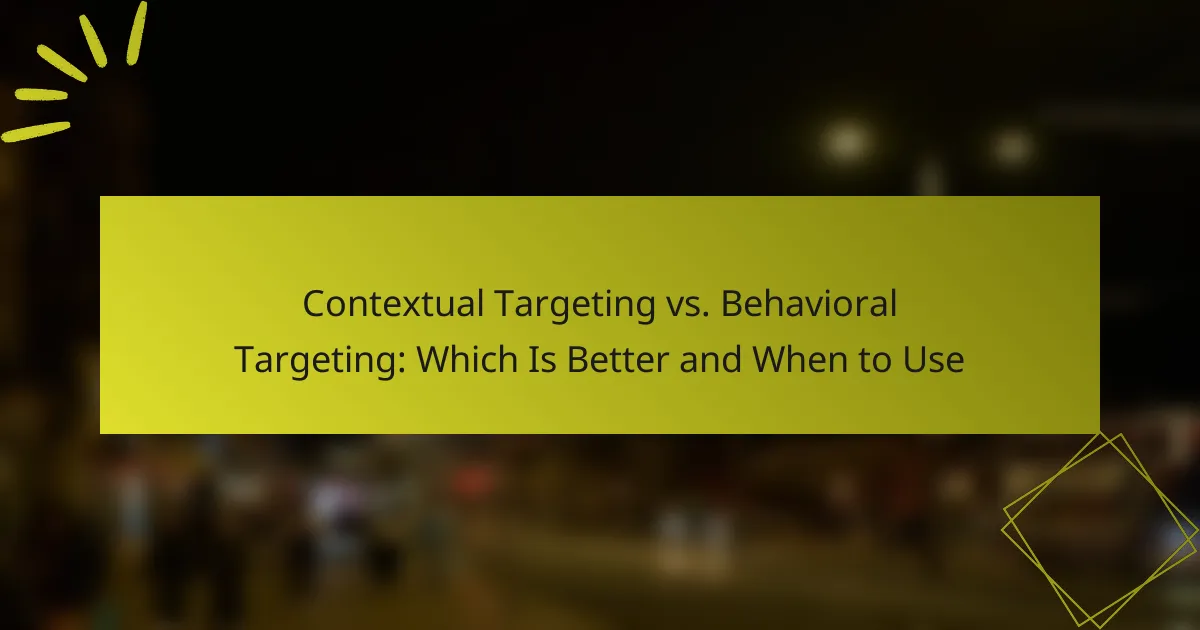Contextual targeting and behavioral targeting are two distinct advertising strategies that aim to enhance ad relevance. Contextual targeting serves ads based on the content of the webpage, while behavioral targeting relies on tracking users’ online behavior to deliver personalized advertisements. Understanding the strengths and applications of each method can help marketers choose the most effective approach for their campaigns.

What is Contextual Targeting?
Contextual targeting is an advertising strategy that serves ads based on the content of the webpage being viewed. This method analyzes the context of the page, such as keywords and themes, to display relevant ads to users without relying on their past behavior.
Definition and Mechanism
Contextual targeting works by scanning the content of a webpage and identifying keywords or topics that align with specific ads. Advertisers create campaigns centered around these keywords, ensuring that their ads appear on pages where the content is relevant to their products or services.
This approach uses algorithms to match ads with content in real-time, allowing for immediate relevance. For instance, an article about fitness may trigger ads for sports equipment or health supplements, enhancing the likelihood of user engagement.
Benefits for Advertisers
One of the primary benefits of contextual targeting is its ability to reach users at the moment they are engaged with relevant content. This can lead to higher click-through rates and conversions compared to other targeting methods. Additionally, it does not rely on user data, making it compliant with privacy regulations.
Advertisers can also benefit from reduced ad fatigue, as users see ads that are directly related to their current interests rather than their past behavior. This can create a more positive user experience and increase brand perception.
Examples in Display Advertising
In display advertising, contextual targeting can be seen in action on news websites, blogs, and forums. For example, a cooking blog may display ads for kitchen appliances or gourmet ingredients, directly appealing to the interests of its readers.
Another example is travel websites that show ads for hotels or flights when users read articles about travel destinations. This targeted approach ensures that the ads are relevant and timely, increasing the chances of user interaction.

What is Behavioral Targeting?
Behavioral targeting is a marketing strategy that focuses on tracking users’ online behavior to deliver personalized advertisements. By analyzing browsing history, search queries, and interactions, advertisers can tailor their messages to align with individual preferences and interests.
Definition and Mechanism
Behavioral targeting involves collecting data on users’ online activities to create detailed profiles. This data can include website visits, clicks, and time spent on specific pages. Advertisers use this information to serve ads that are relevant to users’ interests, increasing the likelihood of engagement.
Mechanically, behavioral targeting relies on cookies and tracking pixels that monitor user behavior across the web. This allows advertisers to follow users as they navigate different sites, ensuring that ads are displayed based on their previous interactions.
Benefits for Advertisers
One of the primary benefits of behavioral targeting is improved ad relevance, which can lead to higher conversion rates. Advertisers can reach potential customers with messages that resonate with their interests, enhancing the effectiveness of their campaigns.
Additionally, behavioral targeting can optimize advertising budgets by reducing wasted impressions on users who are unlikely to engage. This targeted approach often results in a better return on investment (ROI) compared to traditional advertising methods.
Examples in Display Advertising
In display advertising, behavioral targeting can manifest in various ways, such as retargeting ads that follow users after they visit a product page but do not make a purchase. For instance, a user who browses athletic shoes might see ads for those specific shoes on different websites they visit later.
Another example is personalized recommendations based on past behavior, where users receive ads for products similar to those they have previously viewed or purchased. This strategy can significantly increase the chances of conversion by reminding users of their interests.

How do Contextual and Behavioral Targeting Compare?
Contextual targeting focuses on the content of a webpage to display relevant ads, while behavioral targeting uses user data and past behavior to serve personalized ads. Both methods aim to improve ad relevance, but they operate on different principles and are suited for various marketing strategies.
Key Differences
Contextual targeting analyzes the content surrounding an ad to determine its relevance, ensuring that ads align with the current interests of users based on what they are viewing. In contrast, behavioral targeting relies on tracking user behavior over time, such as browsing history and interactions, to predict future interests and deliver tailored ads.
Another significant difference is privacy concerns; contextual targeting is generally seen as less intrusive since it does not require personal data. Behavioral targeting, while potentially more effective in reaching the right audience, raises privacy issues and may be subject to stricter regulations in many regions.
Performance Metrics
When evaluating the effectiveness of contextual targeting, key metrics include click-through rates (CTR) and engagement levels on the content where ads are placed. High CTRs can indicate that the ad is relevant to the content, which can lead to improved brand awareness and customer interest.
For behavioral targeting, metrics such as conversion rates and return on ad spend (ROAS) are crucial. These metrics help assess how well the ads convert viewers into customers based on their previous interactions and preferences. A successful behavioral campaign typically shows higher conversion rates compared to contextual strategies.
Use Cases for Each
Contextual targeting is ideal for brands looking to reach users in specific contexts, such as promoting travel deals on travel blogs or advertising cooking products on food websites. This method works well for campaigns that aim to capture immediate interest based on current content consumption.
Behavioral targeting is more suitable for brands with a strong online presence that want to retarget users who have previously shown interest in their products. For example, an e-commerce site can use behavioral targeting to remind users of items they viewed but did not purchase, increasing the chances of conversion.

When Should You Use Contextual Targeting?
Contextual targeting is best used when you want to reach users based on the content they are currently engaging with, rather than their past behavior. This method is particularly effective in environments where user privacy is a concern, as it does not rely on personal data.
Best Scenarios for Contextual Targeting
Utilize contextual targeting when advertising on platforms with diverse content, such as news websites or blogs. It works well for campaigns aiming to align products with relevant topics, ensuring that ads appear alongside content that resonates with the audience’s current interests.
Consider this approach for short-term campaigns or promotions, where immediate relevance can drive higher engagement. For instance, a sports drink ad on a fitness blog during a major sports event can capture the attention of health-conscious readers.
Industry Examples
In the travel industry, contextual targeting can be effective when ads for vacation packages appear on travel blogs or destination guides. This alignment increases the likelihood that potential travelers will engage with the ad.
Retail brands often use contextual targeting during seasonal events. For example, ads for winter clothing can be placed on fashion websites featuring winter style guides, reaching consumers who are actively seeking related products.

When Should You Use Behavioral Targeting?
Behavioral targeting is most effective when you want to reach users based on their past online behavior, such as browsing history or previous purchases. This approach allows marketers to deliver personalized ads that resonate with individual preferences and increase conversion rates.
Best Scenarios for Behavioral Targeting
Utilize behavioral targeting when you have access to rich data about user interactions, such as website visits, clicks, and purchases. It works well for e-commerce platforms aiming to retarget users who abandoned their shopping carts or browsed specific products without completing a purchase.
Another ideal scenario is during promotional campaigns where you want to engage users who have shown interest in similar products or services. This method can significantly enhance the effectiveness of your marketing efforts by focusing on users likely to convert.
Industry Examples
In the retail sector, companies like Amazon use behavioral targeting to recommend products based on users’ browsing and purchase history, effectively driving additional sales. For instance, if a user frequently searches for fitness gear, they may see ads for related items, increasing the likelihood of a purchase.
In the travel industry, airlines and booking sites often employ behavioral targeting to remind users of flights they viewed or to offer discounts on destinations they searched. This strategy not only encourages bookings but also helps in maintaining engagement with potential travelers.

What Are the Challenges of Each Approach?
Both contextual targeting and behavioral targeting face distinct challenges that can impact their effectiveness. Contextual targeting relies on the content of the webpage, which may not always align with user intent, while behavioral targeting depends on past user behavior, which can lead to privacy concerns and data accuracy issues.
Limitations of Contextual Targeting
Contextual targeting can struggle with relevance since it focuses solely on the content of the page rather than the user’s specific interests or needs. For example, ads displayed on a cooking blog may not resonate with a user who is interested in fitness, even if the content is contextually appropriate.
Additionally, this approach may miss opportunities for personalization, as it does not consider the user’s previous interactions or preferences. As a result, the conversion rates may be lower compared to more tailored advertising strategies.
Limitations of Behavioral Targeting
Behavioral targeting often faces challenges related to privacy and data regulations, such as GDPR in Europe or CCPA in California. Users may feel uncomfortable with their browsing history being tracked, leading to potential backlash against brands that employ aggressive targeting tactics.
Moreover, the accuracy of behavioral data can fluctuate, as users may change their interests or habits over time. This can result in ads that no longer align with the user’s current preferences, diminishing the effectiveness of the targeting strategy.

How to Choose Between Contextual and Behavioral Targeting?
Choosing between contextual and behavioral targeting depends on your campaign goals and audience understanding. Contextual targeting focuses on the content surrounding ads, while behavioral targeting relies on user data and past interactions to deliver personalized ads.
Understanding Contextual Targeting
Contextual targeting involves placing ads based on the content of the webpage where they appear. This method analyzes keywords, themes, and topics to determine relevance, ensuring that ads align with the user’s current interests. For example, an ad for hiking gear may appear on an outdoor adventure blog.
One advantage of contextual targeting is its privacy-friendly approach, as it does not rely on user data. This can be particularly beneficial in regions with strict data protection regulations, such as the EU’s GDPR. Advertisers can reach audiences effectively without tracking individual behavior.
Understanding Behavioral Targeting
Behavioral targeting uses data collected from users’ online activities to serve personalized ads. This includes browsing history, search queries, and previous interactions with ads. For instance, if a user frequently visits travel sites, they might see ads for vacation packages tailored to their interests.
This method can lead to higher conversion rates since the ads are more relevant to the user’s preferences. However, it requires careful management of user data to comply with privacy laws, such as the California Consumer Privacy Act (CCPA) in the U.S. Advertisers must balance personalization with user consent.
When to Use Each Targeting Method
Contextual targeting is ideal when you want to reach a broad audience quickly, especially in industries where brand safety is a concern. It works well for campaigns focused on awareness and engagement, as it capitalizes on the immediate context of user attention.
On the other hand, behavioral targeting is more effective for campaigns aimed at conversion and retention. If you have access to rich user data and want to create personalized experiences, behavioral targeting can significantly enhance your advertising effectiveness.



